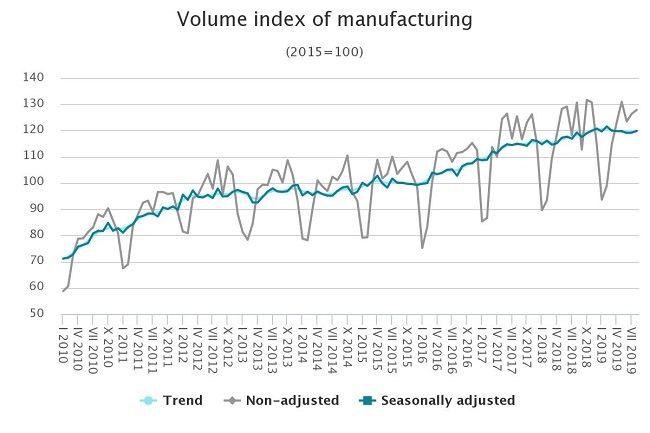Analytics, Industry, Latvia, Statistics
International Internet Magazine. Baltic States news & analytics
Tuesday, 23.12.2025, 07:29
Latvia: In August, industrial production output rose by 2%
 Print version
Print versionCompared to the corresponding month of the previous year, output rise still was recorded in manufacture of fabricated metal products, except machinery and equipment (of 20.9%), manufacture of electrical equipment as well as manufacture of textiles (15.1% in each). Upturn was also registered in manufacture of computer, electronic and optical products (of 9.8%).
Industrial production output drop, in turn, was observed in manufacture of wearing apparel (of 16%), manufacture of beverages (14.2%), and manufacture of chemicals and chemical products (11%). Decline was also recorded in two out of the three manufacturing sectors having the largest share in industrial production: manufacture of wood and of products of wood and cork, except furniture, and manufacture of food products (of 6.4% and 1%, respectively).
Compared to July 2019, in August 2019 industrial production output, increased by 3% (according to seasonally adjusted data at constant prices), of which in manufacturing by 0.6%, in mining and quarrying by 3%, and in electricity and gas supply by 12.4%.

Changes
in industrial production output
(as per cent, at constant
prices)
|
|
January–August
2019 compared
to January–August
2018 (calendar
adjusted) |
August
2019, compared to |
|
|
July 2019 (seasonally
adjusted) |
August
2018 (calendar
adjusted) |
||
|
Total industrial production |
0.3 |
3.0 |
2.0 |
|
Mining and quarrying |
0.1 |
3.0 |
-8.3 |
|
Manufacturing |
2.7 |
0.6 |
0.4 |
|
Manufacture of food products |
-0.6 |
-1.8 |
-1.0 |
|
Manufacture of beverages |
-1.7 |
-1.9 |
-14.2 |
|
Manufacture of textiles |
6.7 |
7.4 |
15.1 |
|
Manufacture of wearing apparel |
-7.0 |
-7.9 |
-16.0 |
|
Manufacture of wood and of products of wood and
cork, except furniture |
0.5 |
1.1 |
-6.4 |
|
Manufacture of paper and paper products |
-1.1 |
-0.2 |
-0.2 |
|
Printing and reproduction of recorded media |
8.7 |
6.1 |
8.3 |
|
Manufacture of chemicals and chemical products |
-5.3 |
4.2 |
-11.0 |
|
Manufacture of other non-metallic mineral products |
-2.8 |
2.2 |
5.7 |
|
Manufacture of fabricated metal products, except
machinery and equipment |
15.0 |
3.6 |
20.9 |
|
Manufacture of computer, electronic and optical
products |
10.1 |
-6.7 |
9.8 |
|
Manufacture of electrical equipment |
23.9 |
1.5 |
15.1 |
|
Manufacture of machinery and equipment |
3.8 |
5.9 |
-4.9 |
|
Manufacture of motor vehicles, trailers and
semi-trailers |
0.8 |
-2.1 |
-5.8 |
|
Manufacture of furniture |
-6.4 |
5.9 |
-1.5 |
|
Repair and installation of machinery and equipment* |
12.2 |
-4.2 |
-0.7 |
|
Electricity and gas supply |
-10.1 |
12.4 |
8.9 |
s a* Repair and maintenance of ships and boats, repair of fabricated metal products, machinery and equipment, installation of industrial machinery and equipment.nd boats, repair of fabricated metal products, m
Manufacturing turnover2
Compared to August 2018, in August 2019 manufacturing turnover increased by 2.5% (according to calendar adjusted data at current prices). Turnover on the domestic market went up by 2.3% and in export by 2.6% (no changes in euro area and rise of 4.9% in non-euro area).
Compared to July 2019, in August 2019 manufacturing turnover rose by 5% (according to seasonally adjusted data). Turnover on the domestic market went up by 1.4% and in export by 7% (of which by 12.4% in euro area and by 2.8% in non-euro area).
Methodological explanations
1The volume index of industrial production describes changes in the volume of industrial production during the reference period in comparison to the base period. The index is estimated by recalculating the production output indicator at constant prices with the help of producer price indices.
2The industrial turnover index measures the monthly development of market demand for industrial goods and services. It is calculated at current prices without excluding price influence. Unlike industrial goods that also include unfinished goods and goods in stock, turnover only includes the goods sold and industrial services provided.








 «The Baltic Course» Is Sold and Stays in Business!
«The Baltic Course» Is Sold and Stays in Business!

